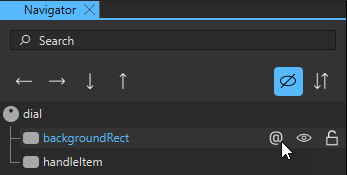UI files
Qt Design Studio wizards create UI files that have the filename extension .ui.qml. Edit the UI files in the 2D view.
If you use the Code view to add code that the 2D view does not support, Qt Design Studio displays error messages.
The following features are not supported in .ui.qml files:
- JavaScript blocks
- Other bindings than pure expressions
- Signal handlers
- States in other components than the root component
- Root components that are not derived from QQuickItem or Item
- Referencing the parent of the root component
The following components are not supported:
- Behavior
- Binding
- Canvas
- Shader Effect
- Timer
- Transform
Supported Methods
Qt Design Studio supports most JavaScript functions that are supported by the QML engine, as well as a subset of Qt QML methods.
This section lists the functions that you can use in .ui.qml files.
JavaScript Functions
As a rule of thumb, pure functions are supported. They only depend on and modify states of parameters that are within their scope, and therefore always return the same results when given the same parameters. This makes it possible to convert and reformat property bindings without breaking the .ui.qml files.
The following JavaScript functions are supported:
charAt()charCodeAt()concat()endsWith()includes()indexOf()isFinite()isNaN()lastIndexOf()substring()toExponential()toFixed()toLocaleLowerCase()toLocaleStringtoLocaleUpperCase()toLowerCase()toPrecision()toString()toUpperCase()valueOf()
In addition, all functions of the Math and Date objects are supported.
For more information, see List of JavaScript Objects and Functions.
Qt QML Methods
Qt Design Studio supports color methods, helper methods for creating objects of specific data types, and translation methods.
The following color methods are supported:
The following helper methods are supported:
- Qt.formatDate()
- Qt.formatDateTime()
- Qt.formatTime()
- Qt.matrix4x4()
- Qt.point()
- Qt.quaternion()
- Qt.rect()
- Qt.size()
- Qt.vector2d()
- Qt.vector3d()
- Qt.vector4d()
The following translation methods are supported:
- qsTr()
- qsTranslate()
- QT_TRANSLATE_NOOP()
- qsTrId()
- QT_TRID_NOOP()
- QT_TR_NOOP()
Note: Do not mix translation methods in a UI file.
For more information about using the methods, see Qt QML Methods.
Using UI files
You can edit the UI files in the 2D and Code views. Components that are supposed to be used in code have to be exported as properties:
Item {
width: 640
height: 480
property alias button: button
Button {
anchors.centerIn: parent
id: button
text: qsTr("Press Me")
}
}The property alias exports the button to the code that uses the form. You can use the  (Export) button in Navigator to export a component as a property:
(Export) button in Navigator to export a component as a property:

In the UI file where the component is used, you can use the button property alias to implement signal handlers, for example. In the following code snippet, the UI file is called MainForm.ui.qml:
MainForm {
anchors.fill: parent
button.onClicked: messageDialog.show(qsTr("Button pressed"))
}You can also assign properties or define behavior or transitions.
To move from the 2D or Navigator view directly to the implementation of a component in the .qml file, right-click the component and select Go to Implementation in the context menu.
Available under certain Qt licenses.
Find out more.

